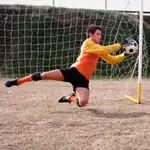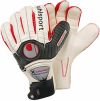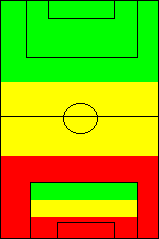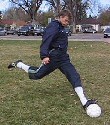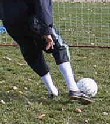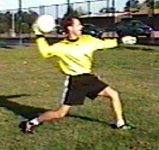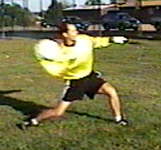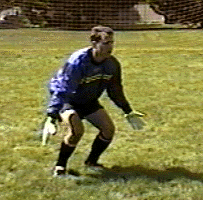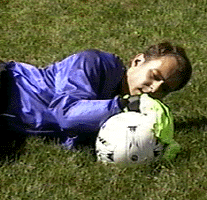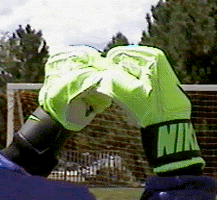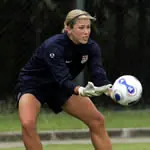 Hope Solo, one of the world's best goalkeepers (AP Photo)
Hope Solo, one of the world's best goalkeepers (AP Photo)Goalkeepers need to be in great shape and prepared to defend every inch of the net behind them during the course of a long game. That means practices have to be productive to prepare you for game day.
This is a great workout that can really help you improve:
Warmup Jog (10 Minutes)
You should start with an easy jog, to warm your body up before you make any sudden movements that might cause you to pull a muscle.
The first five minutes should be a straight-ahead jog. The next five minutes should include a more active jog in which you should begin shuffling, skipping, touching toes, etc. (all of this should be done without stopping).
Stretching (5 Minutes)
Stretching is something that everyone must do to prepare your muscles for a tough workout. Make sure to stretch all of the major muscle group in a slow controlled stretch.
Handling (10 Minutes)
Note: Another player or coach is needed as a server from here on out during the workout.
Make sure that there is no diving during this part of the handling--you are just trying to work on smoothly receiving shots into your hands.
Start with straight-ahead volleys into your hands (take about 20-30). Then, start to move from post to post as balls are being served to your hands as you reach each post. Next, have the server play balls along the ground as you continue to shuffle from post to post.
Take a minute to rest so you are fresh and ready for you next set.
Next, have the server play balls out of his/her hands up towards the upper corners of the net so you have to jump for the service (make sure service is not too far as we do not want to overextend ourselves at this point in the training). Then, take another rest and stretch some more.
Diving/Rhythm Work (30 Minutes)
While seated, have the server toss or kick balls to both your right and left using proper catching technique. Obviously, catch the ball and return back to the server. Then, switch from side to side and take about 20-30 repetitions.
Next, from a standing position, have the server play balls off the ground at mid-range height to your right side only (take 6-10 reps). Then, perform above drill to your left side. After that, perform the above drill while alternating from side to side.
Finally, perform the previous three drills over but have all balls served on the ground.
Now, place six cones on the ground in a line and about two feet apart from each other. At the end of the cones, put two cones about six yards apart from each other to simulate two goalposts. The goalposts will be located at the end of the cones.
Then, shuffle through the cones. As you get to the end, step into the goal and have the server place balls at mid-range height to your right side. Catch each serve and return it to the server. Then, go back to first cone and start over (take 6-10 reps).
Think it's over yet? You haven't even started. Perform above drill to your left side, then do it while alternating from side to side. After that, perform previous three drills over again, but have all balls served on the ground.
Power Diving (10 Minutes)
This kind of training will really help your body to fly for those tough shots in the corners of the goal.
Place a cone one yard inside each goalpost on the goal line. You should start in the middle of the goal and the server should start somewhere between the penalty spot and the 18-yard line, depending on the accuracy of the server. When the server says to start, the goalkeeper should shuffle as quickly as possible to the cone on the left, and as the goalkeeper touches the cone, the server should toss the ball to the opposite post.
The server should make it a shot that is difficult for the goalkeeper to get to, but not so difficult that a full-out lunge wont do the trick. Do two in a row, come back to the center of the goal, take about five seconds and start in the other direction (take 6-10 reps).
For the next drill, the server should have six to eight balls lined up on the penalty spot. When the server says go, the first ball should be served to the right of the goalkeeper, making the goalkeeper dive to make the save either by catching the shot or parrying the shot and immediately serve the next ball the opposite side of the goal and repeat with all six to eight balls.
Crossing (10 Minutes)
A good training session wouldn't be complete without receiving a number of crossed balls from different angles, heights and speeds.
Start with your server playing a ball into the box from each side of the penalty area. Try and catch each ball at its highest point possible. If there are others around during your training, ask them to come and stand in and around the six-yard box, as this will give you some distraction while handling crosses and make it more like a game situation.
Fitness (Doggies)
Unfortunately, goalkeepers have to be as fit as any other player on the field. Fitness is also important for preventing injury. So, we have to run.
Start on the goal line and sprint to the six-yard box; back to the goal line; then to the penalty spot; back to the goal line; then to the top of the 18-yard box and back to the goal line. This is one repetition.
It sounds harsh, but repeat this four times. Take a one-minute rest and then perform the same doggy three more times. And dont forget: take part in team fitness training.
Cool Down (5-Minute Stretch)
Stretching after training is just as important as stretching before training.
Make sure to stretch all major muscle groups and take a light jog to cool down. Dont be afraid to do 50 push-ups and 150 sit-ups either--strength training is important for preventing injury.
Goalkeeping is all about consistency, and if you train every day, you need to have a work out that you are comfortable with.
